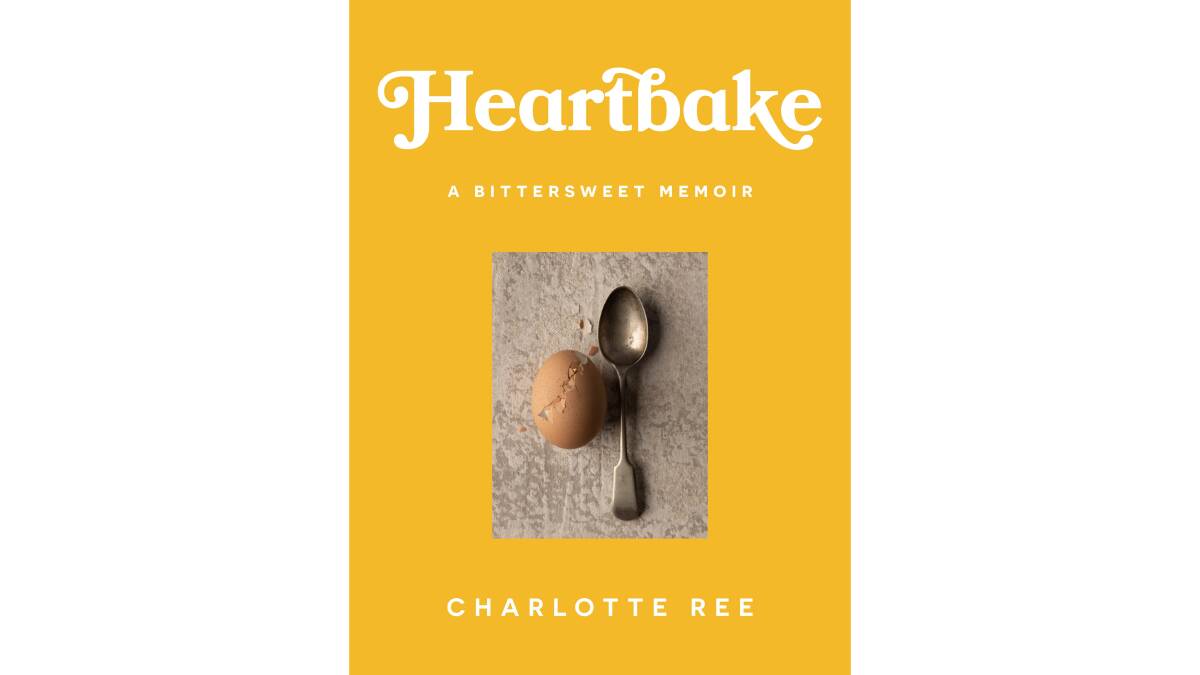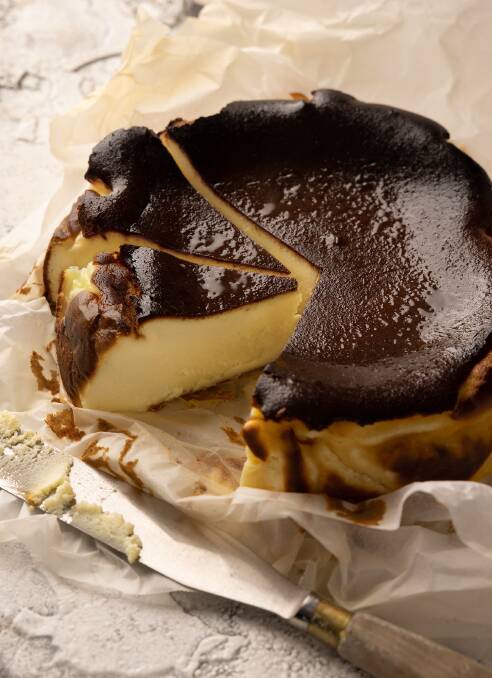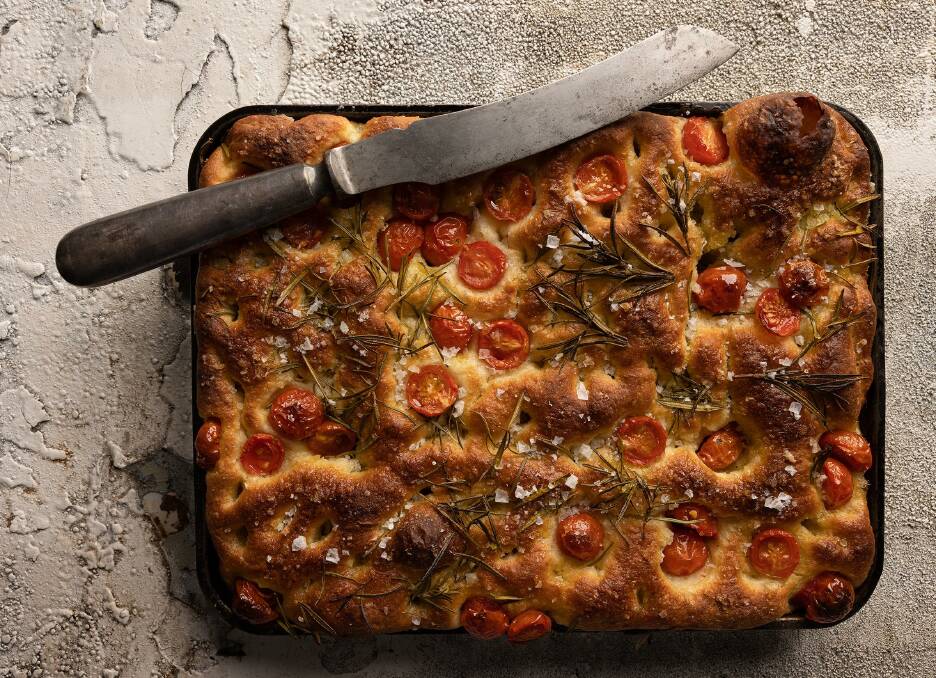
I remember Charlotte Ree's wedding. Our paths had crossed a few years earlier through her role as a book publicist and our correspondence became more familiar as time went on. We had similar interests, mainly books and food, and our emails often included personal notes and anecdotes; we'd share recipes and talk about dishes we'd eaten, she knew what my kids were up to, I knew she was finally getting married to the love of her life.
Subscribe now for unlimited access.
$0/
(min cost $0)
or signup to continue reading
When she returned from her honeymoon she sent me some photographs. Her tulle gown featured hand-painted florals in bright colours on ivory silk, they danced under 200-year-old fig trees, there were cakes everywhere, nine to be exact, chocolate and raspberry buttercream, tiered chocolate cakes, salted caramel tarts. Champagne flowed, there was an ice cream cart and guests consumed 280 scoops throughout the celebration. Everyone looked so full of joy.
But two years later Ree was single again, the marriage held secrets of financial and sexual incompatibility. She was riddled with doubt, saturated in shame and consumed by hauntings of failure.
And all she was eating was hard-boiled eggs.
"I come from a long line of home cooks and feeders," she writes in her memoir, Heartbake: A bittersweet memoir.

"We would eat when we were happy, we would eat when we were sad. But in the aftermath of my marriage, I found no joy in food. I found myself with no hunger, no appetite for cooking.
"Even though the decision to leave was mine, I couldn't escape the stomach-churning sadness of our break-up."
Ree has peeled back so many layers in this book. It's confronting, raw, funny, candid, heart-breaking. As someone who's also gone through a divorce, it stirred so many emotions, things which had been simmering on the stove, so to speak, were now on a rolling boil. There's the panic attacks, the insomnia, the questionable choices - particularly ones involving sex and alcohol - the unshakeable shadow of wondering if you'll ever be enough for anyone, the loneliness, a hunger.
Forty-eight hours after Ree moved into her own apartment, Sydney went into lockdown. In the months that followed she went through cartons of eggs every week. She'd boil them, with a drizzle of extra virgin olive oil and drown them in sea salt flakes and black pepper. Some days she might scramble them, or make an omelette, but it was always eggs.
While she wasn't eating, she was cooking. She left notes on the doors of her new neighbours alongside banana muffins, she baked trays of focaccia, curries and stews, rolls of cookie dough, a lasagne that would take her six hours, all to be shared.
You're probably wondering why a story like this belongs in the Food & Wine pages, but it's for this very reason. Food brings people together, the process of cooking grounds some people, Ree and I included, so many memories involve food, it's a sensual experience every time, whether you're dipping toast in the runny yolk of a boiled egg or sipping champagne off someone's soft belly.
Four years down the track from that first heartbreak, one from the breakdown of a new relationship, one she didn't see coming, which bookends the story, Ree, now 31, looks back at it all with a clear head. She's cooking and eating again.
"I know that if the past few years have taught me anything, it's that the relationship you have with yourself is the single most important relationship you will ever have," she says. "It was all so painful but it was so beautiful to feel that light again when I did get the desire to cook, that desire to feed, feed myself, feed others, I knew then I'd be ok."
We talk about how important it is to learn how to feed yourself, post break-up, to come to a realisation that you are worthy of the time and effort it takes to make a meal.
"It was a revelation to me that it was okay to not have any desire to cook for anyone else, that it wasn't selfish," she says.
I don't feel so alone when I roast a whole chicken, and potatoes, onions and pumpkin, on a Sunday night knowing that the love will be in the fridge for the next few days. Ree feels the same. We are worth it.
"All the different ways I can use the leftovers, from making a stock, to a roast chicken sandwich, it's so simple and comforting and nourishing and the glory of doing that for yourself is so healing in so many ways."
Writing it all down has been healing too, she says. She was going through the second break-up as the book was in its final stages.
"The process of writing it was so therapeutic," she says. "Understanding more about myself on that level, having to think about things again."
The story starts in her childhood, her young mother raising two children on her own, a loving stepfather, her mother's mental illness, but always a house full of love and food. Her mother has read the book - "She'll never forgive me for the threesome" - proud of the way her daughter has communicated her illness.
"It's infuriating how much stigma there still is about mental illness and little talk about how hard it is for children that have grown up with it. I'm so lucky to have had the most magnificent parents.
"I remember once mum said to me, 'Do you ever wish you had a normal mummy?' and I said no, in my eyes you are normal, you're my normal. Mum is still so exciting and fun and so, so loving. I couldn't have written the book without her support."
Her ex husband and latest ex partner have read it too and both have also given her their support.
"My ex was the the first person I sent it to, he's not a reader by any stretch, but he rang me and said he'd read it from start to finish in one sitting.
"He said he didn't necessarily agree with everything I'd written but that he understood that was how I was made to feel. He wished me all the best and wanted the book to be everything it could be. I loved him so much and I know a part of me will always love him and we want nothing but the best for each other."
Is this a cookbook, a memoir, something in between? In many ways it's like one of those meals that's comprised of all the things you like to eat. You're savouring flavours even if the juxtaposition seems odd. There are recipes, for all the dishes that are important, the lasagne, her pa's pesto, the banana muffins, a better-than-sex tiramisu she ate alone after a disastrous date. And yes instructions on how to boil an egg.
We finish our conversation with a promise to catch up for a meal when she's in Canberra on May 24, where we'll talk about Heartbake. She wants to cook for me, I want to cook for her. It's how we show love.
- Charlotte Ree will be in conversation about Heartbake: A bittersweet memoir, with Karen Hardy on May 24 at 5pm. Presented by Winning Appliances, The Book Cow and The Essential Ingredient. Tickets $16, includes a glass of wine from Capital Wines or a non-alcoholic drink on arrival. At Winning Appliances showroom at 80 Giles St, Kingston. Tickets via Eventbrite
Burnt Basque cheesecake

I cannot stop baking this cheesecake. It's a cake so good it will make you cry. A cake that is impossible to stuff up because it's a cake that wants nothing more than to be burnt and blistered, cracked and crinkled, and yet still comes through in a cloud of captivating creaminess. A cake that is so perfectly imperfect, I long to bake it again and again and again because life is like that - perfect in all of its imperfections.
Ingredients
- 1kg cream cheese, at room temperature
- 300g caster sugar
- 6 free range eggs, at room temperature
- 500ml thickened cream
- 2 tsp vanilla bean paste
- 80g plain flour
Method
1. Line a 20cm springform cake tin with baking paper. There is no art or precision to this, I simply tear two sheets of paper and crisscross them so the paper extends above the height of your chosen tin. Preheat the oven to 200°C.
2. Beat the cream cheese and sugar in the bowl of an electric mixer fitted with a whisk attachment until smooth. Add the eggs, one at a time, whisking after each addition to combine. With a large spatula, scrape down the side of the bowl before adding the cream and vanilla and mixing to combine.
3. Scrape down the side of the bowl once more, add the flour and mix to create a silky smooth batter. Pour into your tin and bake for 65-70 minutes, until you see the cheesecake's deliciously darkened top. Remove from the oven. The cake will still wobble as though it is undercooked, but as it cools it will harden.
4. Leave it in the tin for 10 minutes before removing it to cool completely. Serve at room temperature, on its own. This cake does not need a single thing added to it.
My comforting lasagne

I recognise this recipe is not traditional, by any means. It features a sauce that has more liquid than some might like and a bechamel that my nanny taught me how to make by sight rather than measurement (which also made it incredibly difficult to convert here). But this is a recipe that is full of my whole heart and one that I have curated, perfected and fawned over for many years. The highest praise of all was in a letter my husband wrote to me after we had separated, which he ended by saying "PS. I think you now finally make a better lasagne than me". And now, you can too.
Ingredients
Sauce:
- 3 celery stalks, grated
- 3 large carrots, grated
- 1 brown onion, diced
- 3 zucchinis, grated
- extra virgin olive oil
- 500g pork mince
- 500g beef mince
- 1 cup dry red wine
- sea salt flakes and freshly ground black pepper
- 800g tinned whole peeled tomatoes (I prefer Mutti brand)
- 140g tomato paste (I prefer Mutti brand)
- 700ml tomato passata (I prefer Mutti brand)
- 1 cup full-cream milk
- 1 tbsp oregano leaves
- 4 garlic cloves, crushed
Pasta:
- 2 batches of pasta dough (see below)
Bechamel:
- 4 tbsp unsalted butter
- 150g plain flour
- 1.5 litres full-cream milk
- 1 tsp ground nutmeg
- 200g Parmigiano Reggiano, grated, plus extra for topping and serving
- 150 g mozzarella, grated, for topping
Method
1. To make the sauce, saute the celery, carrot, onion and zucchini in a heavy-based cast-iron pot with olive oil on medium heat until softened. Add the pork and beef minces and break them into small, pea-sized pieces with your wooden spoon. Brown slightly and add your red wine. Season with salt and pepper. Continue to cook the meat until it browns, and the wine reduces. Add the tomatoes, tomato paste and passata. Stir. Cook till everything bubbles, then turn the heat down to low. Add the milk, oregano and garlic as well as some more salt and pepper if needed. Cook, stirring occasionally, for a minimum of six hours.
2. Once your sauce has been made, make the pasta. Be sure to make a double batch. Once you've finished, leave in a cool dark place while you make your bechamel.
3. Preheat the oven to 180C and prepare your chosen baking dish by drizzling the bottom with some extra virgin olive oil.
4. To make the bechamel, melt the butter in a large saucepan over medium heat. Add the flour and whisk constantly for three or so minutes, until the mixture begins to cook and form bubbles. Gradually add the milk, whisking constantly to avoid any lumps forming. Slowly bring to the boil, continuing to stir as the sauce thickens, for about eight or so minutes. You want a beautifully thick but still slightly runny bechamel, like a gravy, that coats the back of a spoon. Once you have reached that consistency, stir through the nutmeg and Parmigiano, seasoning with salt and pepper. Note that the bechamel can become too thick if it is left for too long while you are layering. If you see this happening to you, simply add some more milk and stir to thin it slightly.
5. Now is the time to roll out the lasagne sheets by dividing the rested dough into four equal parts and rolling each sheet with a pasta roller to approximately 1.2mm thick. You may need two sets of hands here and may need to add a little extra showering of flour to each quarter to stop it sticking. I normally store my rolled sheets on my portable clothes drying rack from Ikea, or on the backs of my dining chairs (thanks to my tiny kitchen), but if I am making them with friends, I simply add them to my baking dish and layer as I go.
6. To construct the lasagne, lightly line the base of your baking dish with some of the sauce and another drizzle of extra virgin olive oil. Place a layer of pasta sheets on top, then spread one-third of your remaining sauce over the pasta, then one third of the bechamel and a drizzle of extra virgin olive oil. Repeat this layering process until you reach your final layer of pasta, which you will top with bechamel and a sprinkling of extra Parmigiano, and then cover with the mozzarella. Bake in the oven for 45 minutes until it is bubbling and golden and you are salivating at the thought!
7. Patience will reward you though. Once you remove your lasagne from the oven, leave it to rest for 10-20 minutes before serving. This will allow the layers to settle into themselves. Scatter with a little more grated Parmigiano and serve.
Serves 8-10.
Pasta
Ingredients
- 300g Tip 00 flour
- 3 large free-range eggs
- Method
1. Make the pasta by combining the flour and eggs in the bowl of your electric mixer fitted with the dough hook. Knead on medium speed for 10 minutes until you have a soft dough - when you gently press your finger into it, the dough will spring back.
2. If you do not have an electric mixer, it is time for an arm workout. Pour the flour onto a clean, dry work surface and make a well in the middle. Pour in the eggs and, using a fork, gently whisk. Using the same fork, slowly incorporate the flour into the well, working clockwise, until a clumpy dough forms.
3. Forego the fork; now is the time to use lightly floured hands. Slowly bring the dough together, forming a ball, and knead for eight to 10 minutes until you can gently press your finger into it, and the dough springs back.
4. In both instances, mixer or handmade, gently flatten your dough ball into a disc and wrap in plastic wrap. Leave it in a cool, dry place for 30 minutes.
David Lovett's focaccia

In the first lockdown, unlike what appeared to be happening in the rest of the world, I never made sourdough bread. I struggled to maintain a starter - not being able to feed myself, I couldn't bring myself to feed it. But I did bake tray after tray of focaccia, and became obsessed with perfecting it, even throughout the great supermarket yeast shortage of 2020. I tried countless recipes in my search for perfection. Some called for the seemingly rogue addition of potato, some begged you not to knead, others compelled you to do so forever. There were recipes that called for your dough to be refrigerated and there was even that infamous one that asks you to leave your dough to ferment at room temperature for 12 to 14 hours. How absurd. I now realise there is just one focaccia recipe you must memorise and bake for the rest of your life. It is my friend David Lovett's focaccia, and it is a masterpiece. You only need to use plain flour, and you don't need to waste your time with strange ingredients or two days of proofing. And you can simply enhance it with any additions of your choosing. I serve it alongside a caprese salad, which I make by combining punnets of halved ripe cherry tomatoes with clouds of creamy stracciatella and a couple of handfuls of torn fresh basil leaves on a large serving platter. I season it well with sea salt and black pepper, and then drizzle olive oil all over. It's the ultimate pairing.
Ingredients
- 350ml tepid water
- 10g dried yeast
- 10g caster sugar
- 500g plain flour, sifted
- 2 tsp fine sea salt
- extra virgin olive oil
- polenta, for dusting
- sea salt flakes, to season
- 250g punnet cherry tomatoes, halved
- 2 tbsp rosemary leaves
- Method
1. Place the water, yeast and sugar in the bowl of your electric mixer fitted with a dough hook and mix to combine. Add the sifted flour and fine sea salt, then mix, scraping down the side occasionally with a spatula to incorporate all the flour, until a sticky dough forms (eight to 10 minutes). This is a wet dough, so be careful not to add more flour than the recipe calls for. The ratios are key.
2. Lightly oil a deep baking tray (mine is around 20 30cm) with the extra virgin olive oil and dust with the polenta. Using a pastry scraper, scrape the dough into a ball and place in your tray.
3. Rub a tablespoon of extra virgin olive oil all over the dough ball and set aside to prove until doubled in size (20-30 minutes; the warmer and more humid the room, the quicker it will prove).
4. Stretch the dough to fill the tray (it should be soft and pillowy; be gentle so as to keep as much air in the dough as possible). Using both hands, lift the dough from underneath and gently stretch and pull it lengthways, then sideways. If it doesn't quite reach the edges, that's fine. As it proves the second time, it will expand further. Drizzle 1 1/2 tablespoons of extra virgin olive oil over the dough and leave to prove for another 10-14 minutes. It will continue to gently rise.
5. Preheat your oven to 240C.
6. Using all your fingers (but not thumbs) on both hands, make deep indents in the dough with your fingertips, then drizzle another 1 1/2 tablespoons of extra virgin olive oil all over. Set aside to prove for a further 10-12 minutes. It will rise even more.
7. Now, when it comes to flavouring your focaccia, the choice is yours. You can leave the homemade dough to shine, serving it with just extra virgin olive oil and sea salt flakes. You could add a sprinkling of oregano leaves, too. You can make what David calls the "Bunnings focaccia" by gently pressing a packet of plain thin pork sausages and two teaspoons of rosemary leaves into your focaccia. You can then serve it with sautéed onions and your favourite sauce. But my go-to is pressing halved cherry tomatoes, cut side up, into the dough, and scattering two tablespoons of rosemary over the top.
8. After adding your flavourings, drizzle on another 1 1/2 tablespoons of extra virgin olive oil and set aside to prove until the dough is popping over the edge of the tray and the oil is about to overflow.
9. Depending on your tray size, you want to aim for your dough to be about 3 cm deep by this point. Season generously with two to three teaspoons of sea salt flakes.
10. Bake until the focaccia is deep golden and sounds hollow when tapped (12-15 minutes). Add one final, generous drizzle of extra virgin olive oil as soon as the focaccia comes out of the oven, then rest in the tray for about five minutes. Turn out on a wire rack to cool for 20-30 minutes.
Serves 6-8.


